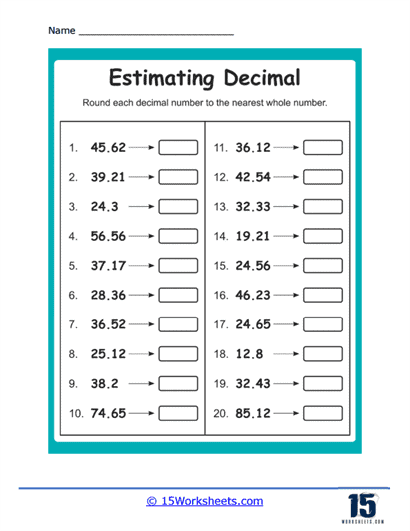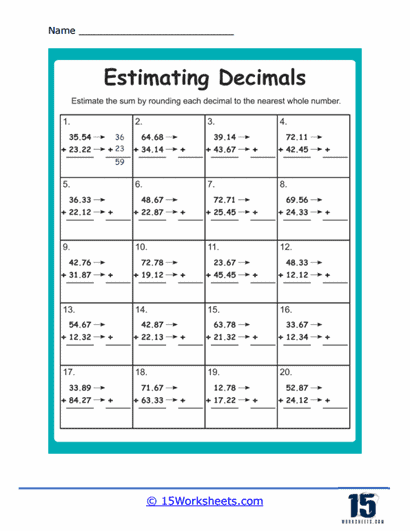Estimating Decimals Worksheets
About These 15 Worksheets
These worksheets will help make you much more comfortable with using decimal notation. You will begin to understand and master the concept of estimation, particularly as it applies to decimals. Decimals are fractions represented in a format that’s easier to understand and work with. They’re based on the number 10 and its powers (such as 10, 100, 1000, and so on), and they can represent anything from the tiny measurements in a scientific experiment to the money in your pocket.
Let’s say you’re buying a toy that costs $4.75 and a book that costs $3.95. If you estimate, or roughly calculate, the costs, you might say the toy is about $5 and the book is about $4. So, you’d estimate the total cost to be $9. This estimation makes mental calculations faster and easier. This skill is not only useful in everyday situations, but it also plays a critical role in more advanced mathematical operations.
These worksheets include various types of exercises to help develop and enhance your ability to estimate decimal numbers. Here are some common types:
Rounding and Estimating – These exercises involve rounding decimal numbers to the nearest whole number, tenth, hundredth, or thousandth before adding or subtracting them. For example, if you need to estimate the sum of 5.37 and 2.86, you might round 5.37 to 5.4 (nearest tenth) and 2.86 to 2.9, then add them to get an estimated sum of 8.3.
Decimal Products – This involves estimating the result (product) of multiplying decimal numbers. For instance, to estimate the product of 7.28 and 4.9, you could round 7.28 to 7 and 4.9 to 5, then multiply to get an estimated product of 35.
Decimal Quotients – Here, you estimate the result (quotient) of dividing decimal numbers. For instance, if you’re estimating the quotient of 9.72 divided by 3.8, you could round 9.72 to 10 and 3.8 to 4, then divide to get an estimated quotient of 2.5.
Estimating Larger Sums and Differences – These problems involve larger sums or differences of multiple decimal numbers.
By regularly practicing with these worksheets, you’ll become quicker and more accurate at estimating decimals. These exercises also help you understand the place value of decimals better, enhancing your overall number sense.
For example, when rounding to the nearest tenth, you start to understand the value and impact of the tenths place in a decimal number. Similarly, when you’re estimating products or quotients, you learn about the behavior of decimal numbers in multiplication and division—how multiplying by a decimal less than 1 makes a number smaller, or how dividing by a decimal less than 1 makes a number larger.
Estimating Decimals Worksheets can also help reinforce other math skills. They can improve your mental math ability, as you’ll often do the rounding and calculating in your head. They also help develop problem-solving skills, as you decide the best way to estimate for each problem. Plus, they build confidence—when you can quickly estimate the answer to a decimal problem, it makes the problem feel less daunting.
We Use This Skill Everyday
Rounding decimal values and performing math operations are crucial skills that come into play in a variety of real-life situations. Here are some examples:
Shopping – When you’re buying items at a store, especially when you’re on a budget, you often round the prices for easier mental calculation. If an item is priced at $3.99, you might round it to $4 to estimate your total bill. When you’re comparing prices or discounts, you might need to subtract or add decimal numbers.
Cooking – Recipes often involve decimal quantities (like 0.5 cup of milk or 1.75 cups of flour), and you might need to double or half these quantities based on the number of servings you’re planning. This requires multiplication or division of decimals.
Traveling – When planning a trip, you might need to calculate the cost of gas. If your car gets 28.5 miles per gallon and gas costs $3.29 per gallon, you’ll need to estimate your total gas cost, which involves rounding and multiplication.
Banking and Budgeting – When managing your finances, you often deal with decimals in the form of interest rates or various expenses. If you’re calculating interest on a loan or figuring out your monthly expenses, you’ll need to round, add, or multiply decimal numbers.
Sports – If you’re tracking your running distance or speed, you’ll often see decimal numbers. If one day you run 2.7 miles and the next day you run 3.2 miles, you might want to add these to know your total distance.
Home Improvements – When you’re measuring for home projects, you often work with decimal measurements. For example, a plank of wood might be 7.5 feet long. If you need three pieces, you’ll have to multiply this decimal.
Environmental Conservation – If you’re trying to reduce your water usage and your shower uses 2.5 gallons of water per minute, you might want to calculate how much water you’d save by reducing your shower time by a few minutes.















